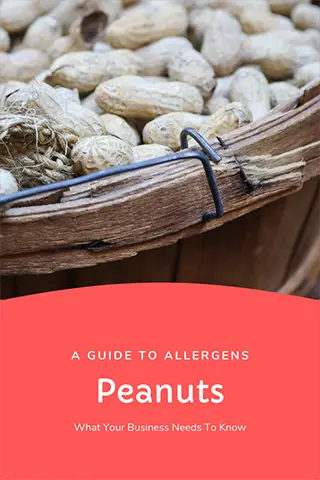
When running a food business you have to be aware of allergens and your responsibilities to monitor their use and inform customers.
Peanut allergy is one of the most common allergies in the world, and is growing at an alarming rate with new research suggesting “that peanut allergy in children has increased 21 percent since 2010, and that nearly 2.5 percent of US children may have an allergy to peanuts.”
Peanut allergies are often very severe, were even small trace amounts can lead to anaphylaxis nearly instantly, which if not treated immediately can lead to death. Due to this people with known peanut allergies often carry adrenalin auto-injectors to counteract the symptoms should the come into contact with peanuts. For more information on the physical symptoms of peanut allergies, see this fact sheet produced by the Anaphylaxis Campaign.
Peanuts are listed separately from other nuts of the list of 14 allergens issued by the Food Standards Agency. This is because they are not actually a nut but are in fact a Legume. People who are allergic to peanuts also have an increased chance of being allergic to Lupin and other nuts such as almonds and pistachios.
Peanuts are listed by the Food Standards Agency as one of the 14 allergens whose inclusion in a product must be clearly labelled.
From 2021 all prepacked products which contain Peanuts as an ingredient, will need to have a label with a full ingredients list with allergenic ingredients emphasised within it.
Foods sold unpackaged, such as a meal in a restaurant musty have full allergen information available for all products either on the menu on in a separate allergen information pack, and there must be signs visible notifying customers how to view this information.
It is vitally important that you are aware of all allergens in products your business sells. If you sell only pre-packaged food that you buy in fully made then this will be clearly labelled on the product. However if you make any items yourselves, you will need to ensure that you check all of the ingredients for peanuts and other allergens and ensure that you keep accurate records of what goes into each dish.
You will also need to have a control system in place to ensure that there is no cross-contamination from the peanuts into other ingredients of dishes. You should look to have ingredients segregated in stock rooms, allergen labels can help with this and you should ensure that all of your staff have had appropriate training. The Food Standards agency has a free basic training course online here and you can get in depth allergen training from Highspeed Training.
You need to ensure that you record how you store allergen ingredients, and how staff are kept informed of the information, you also need to make sure that and part made ingredients such as sauces or stock powders are constantly checked as the manufacture could change the recipe and include peanuts. You should not use any ingredients where allergen information is unknown.
Peanuts are very popular in certain regional styles of cooking, they are common in Chinese, Indonesian, Thai, Vietnamese, Indian, African and Mexican dishes, so you should pay special attention when looking at any style of dish from these regions.
They are also a common ingredient in European cakes or pastries, often used in conjunction with other nuts as a cheap “Nutty” bulk ingredient, as well as in spreads, chocolate bars, pralines, trail mixes, Pesto’s, granola bars and soup mixes.
The UK Anaphylaxis campaign advise against banning peanuts completely from buildings. In their 2015 advice to schools they say
“The Anaphylaxis Campaign has never promoted the banning of peanuts, nuts or other allergens, from schools, pointing out that there is a drawback to this:
First, no school could guarantee a truly peanut/nut-free environment. Allergic children might be led into a false sense of security.” - Anaphylaxis Campaign Advice for schools
Ultimately you should make the best decision for yourself and customers, however the Anaphylaxis campaign note that by banning things you often increase the risk. “Third, demands for nut-free zones may engender confrontation between parents. In such an atmosphere, the risks may actually increase.”
For more information and training on how to deal with Peanuts allergens in your food business, check out Highspeed Training.
You can also read our articles on Food Safety Hazards – Types of Food Contamination and An Introduction to HACCP which will help you identify ways to reduce risks from allergens.